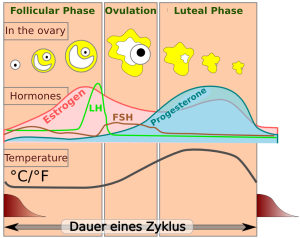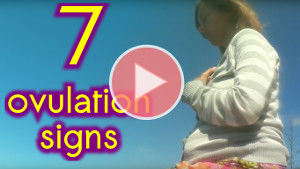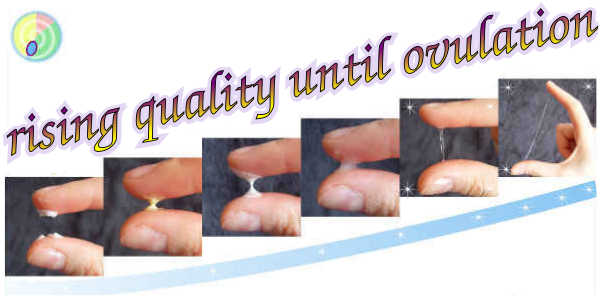The 7 most important signs of ovulation from basal body temperature to cervical mucus and how you can use them to get pregnant faster.
There are many signs of ovulation, but only a few that will really help you. In this article, you will learn about the 7 most important signs of ovulation. After you have read all 7 ovulation signs, YOU will know when your individual ovulation is and can have sex on these days to become pregnant with very high probability. Interested? So let’s go!
1. Basal body temperature
The basal body temperature is the only body sign you can observe and it can tell you exactly if you had ovulation. To do this, however, you need to measure your basal body temperature with a suitable Basal thermometer daily, for example, under the tongue for three minutes shortly after waking up and before getting up. If you enter your readings into a cycle sheet every day, you will get the basal temperature curve. The basal body temperature curve shows three phases if you had ovulation.

1. Maturation Phase (low position)
In the low position, the temperature is lower compared to the peak. In this phase, the maturity takes place.
2. Ovulation (temperature rise)
The basal body temperature rises around ovulation. The temperature increase is caused by the hormone progesterone (corpus luteum hormone), which is increasingly formed after ovulation.
3. Luteal phase (high position)
If a sufficient amount of progesterone is produced, the basal body temperature remains high. If you become pregnant, your basal body temperature will be increased. This increase in temperature is necessary so that the body functions are sufficiently stimulated for tissue construction (building the uterine lining, preparing the implant, making the baby grow) etc. If you have not become pregnant, your basal body temperature drops again and menstrual bleeding occurs.
I would like to say at this point, however, that the Temperature method alone is not particularly well suited to becoming pregnant. This has two reasons: first, the temperature usually only increases shortly after ovulation. So this is usually too late because you want to know when the ovulation is imminent. For this reason, I can only recommend you to employ the Symptothermal Method that combines temperature AND the cervical mucus or cervix. Then you can determine your highly fertile days in almost every cycle and also get clear ovulation signs before Ovulation occurs.
2. Cervical mucus
The cervical mucus is, in my opinion, the most important sign of the highly fertile days and ovulation. In contrast to the basal body temperature, which only rises shortly after ovulation, the cervical mucus changes very clearly BEFORE ovulation. For this reason, it is also useful to combine cervical mucus and basal body temperature because with the cervical mucus it is possible to determine when the ovulation will come with a high probability and with the basal body temperature when it is definitely over. So far so good, but how does the cervical mucus change? Basically, I would like to say that the cervical mucus is different for every woman and every cycle. However, there are a few things that are worth knowing. The closer the ovulation approaches, the higher the water content in the mucus. This is because the cervical mucus is associated with the hormone estrogen, which is increasingly produced during maturation. So if the egg is already just about jumping, the estrogen level is usually at its maximum, so the cervical mucus has the highest water content just before ovulation. One can imagine the cervical mucus as a kind of pond in the vagina, which supplies the sperm with food and at the time of ovulation, it becomes more watery so that as many sperms as possible find the way to the egg. The best cervical mucus quality is different in each individual. Possible characteristics of the cervical mucus with increasing quality are shown in the graph below.
Many women can observe around ovulation how the cervical mucus is becoming more transparent and spinnable. Some women can then spin centimeters long threads with their mucus. On these days you are highly fertile and it is the best time to have sex with your partner if you want to have a baby. After ovulation, the water content in the mucus decreases again and the cervical mucus becomes lumpy, whitish and sticky. Those who try to get pregnant by means of cervical mucus alone, unfortunately, have a major disadvantage, because the cervical mucus is indeed a great characteristic indication of ovulation, but it is not an all-rounder. For example, it is not possible to determine clearly whether you have ovulated and whether you have become pregnant based on the cervical mucus history. If you really want to know when your highly fertile period starts and when it ends, then I recommend you once again the Symptothermal Method.
3. Cervix
Is your cervical mucus not clear enough or do you have very little cervical mucus and want an additional ovulation sign? In this case, the cervix is a very helpful ovulation sign. Shortly before ovulation, the cervix opens and becomes increasingly softer. Likewise, it may change its position.
 You can imagine the cervix as a door that opens so that the sperm can pass through at the time of ovulation to fertilize the egg. After ovulation, the door (the cervix) again becomes firm, hard and closed. However, it takes some practice at the beginning to be able to perceive the subtle differences. It is best to feel your cervix once a day, in the same position with the same finger and at the same time of the day. You can use the cervix as a substitute for the cervical mucus or as an additional ovulation sign.
You can imagine the cervix as a door that opens so that the sperm can pass through at the time of ovulation to fertilize the egg. After ovulation, the door (the cervix) again becomes firm, hard and closed. However, it takes some practice at the beginning to be able to perceive the subtle differences. It is best to feel your cervix once a day, in the same position with the same finger and at the same time of the day. You can use the cervix as a substitute for the cervical mucus or as an additional ovulation sign.
4. Ovulation Pain
Many women just before ovulation feel a pulling or stinging in the lower pelvis or back area. Surveys show that more than 60% of women who have been observing their cycle notice ovulation pain. Conversely, however, 40% do not observe ovulation pain during the cycle. This is one of the reasons why ovulation pain, unlike cervical mucus, cervix or temperature is not seen as a major sign of ovulation, but as a secondary sign. In addition, ovulation pain which I explained in detail in my post ”Does Ovulation pain indicate Ovulation?” according to studies can vary up to 9 days before and 4 days after ovulation. So it is really only a rough orientation and can not be used directly to limit the ovulation time. Nevertheless, I recommend that you have sex on days of noticeable ovulation pain if you want to become pregnant.
5. Ovulational bleeding
Another secondary sign for ovulation is the ovulational bleeding, i.e. a bleeding within the highly fertile period. It occurs as a result of the fact that the estrogen level may drop relatively rapidly shortly before ovulation or after ovulation. Medically speaking, the uterine lining can no longer be kept for a short time because the estrogen level has fallen below a critical limit and as a result, there is no short intermediate or medium bleeding. Ovulation bleeding is much weaker in most women than the usual menstrual bleeding and also rarely occurs. Only 3 percent of women can observe them every cycle, according to a survey from the Symptothermal Method Forum in GERMANY, at least 17 percent notice it every now and then. Some women tend to have ovulation bleeding more frequently – if you notice such a slight bleeding or spotting outside your menstruation, use this day too ♡!
6. Ovulation Dreams
My wife Anne and I regularly document our dreams. In the process, Anne noticed that she often have erotic dreams during the highly fertile period. In a small Ovulation Dream-Experiment, Anne was able to show that for almost a year she could document an ovulation dream almost every single cycle within the highly fertile period. The phenomenon of ovulation dreams has not yet been studied clinically, but Anne and I find that it is simply another ovulation sign that you can use for yourself (if you have erotic dreams and can remember them the next morning ).
7. Ovulation test
Many women try to use ovulation tests as signs of ovulation. Basically, the idea of an ovulation test is quite good, because the luteinizing hormone (LH) has been proven to rise very rapidly before ovulation, and in the opinion of scientists, is presumably in direct connection with the triggering of ovulation. In practice, however, the tests show some weaknesses. First, the LH level can fluctuate over the day (hourly!), so it can theoretically show positive as well as negative on the same day. Secondly, the LH hormone is not the only hormone suspected of inducing ovulation. Currently, hundreds of sex hormones have not been studied in this complex process. Anne has had extensive experience with LH Tests and they were mostly negative, despite having been proven to ovulate.
My Summary & Conclusion
Did you know before reading this post that there are so many unique ovulation signs? To summarize, if you want to get pregnant, have unprotected SEX on days during which your temperature rises, on days with your best individual cervical mucus quality, on days with soft/open/high-standing cervix, on days with ovulation pains, on days with intermenstrual bleeding outside of your period, on days after erotic ovulation dreams and on days with positive Ovulation tests. We really tried a lot to determine the fertile days and ovulation. LH tests did not work well with my partner and the ovulation calculators did not work. But with the Symptothermal Method, my partner became pregnant in the first cycle. And that was no coincidence because 81% of the women who use the Symptothermal method when they want to have children become pregnant within the first 6 months. If you really want to move forward and make a big step towards your desired child, I recommend you my ebook “WHEN AM I FERTILE?”. This Ebook brings together almost all of my best fertility tips that you can put into practice right away. Many women have successfully become pregnant with the help of this book.
We Send Fertile Greetings
♡Anne & Marcus♡





